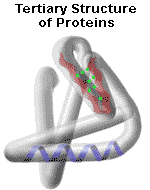
Amino acids play central roles both as building blocks of proteins and as intermediates in metabolism. The 20 amino acids that are found within proteins convey a vast array of chemical versatility. Tertiary Structure of a proteinThe precise amino acid content, and the sequence of those amino acids, of a specific protein, is determined by the sequence of the bases in the gene that encodes that protein. The chemical properties of the amino acids of proteins determine the biological activity of the protein. Proteins not only catalyze all (or most) of the reactions in living cells, they control virtually all cellular process. In addition, proteins contain within their amino acid sequences the necessary information to determine how that protein will fold into a three dimensional structure, and the stability of the resulting structure. The field of protein folding and stability has been a critically important area of research for years, and remains today one of the great unsolved mysteries. It is, however, being actively investigated, and progress is being made every day.
As we learn about amino acids, it is important to keep in mind that one of the more important reasons to understand amino acid structure and properties is to be able to understand protein structure and properties. We will see that the vastly complex characteristics of even a small, relatively simple, protein are a composite of the properties of the amino acids which comprise the protein.
full text:[url=]http://www.biology.arizona.edu/biochemistry/problem_sets/aa/aa.html[/url]
Tagler: Hiç etiket yok
Comments:  (0)
(0)
Henüz yorum yapılmamış